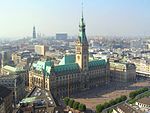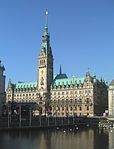Jungfernstieg station
Buildings and structures in Hamburg-MitteHamburg S-Bahn stations in HamburgHamburg U-Bahn stations in HamburgRailway stations in Germany opened in 1931Railway stations located underground in Germany

Jungfernstieg (German pronunciation: [juːŋfɛʀnstiːk]) is an underground railway station in the city centre of Hamburg, Germany, served by the underground railway (U-Bahn) and the suburban railway (S-Bahn). The station is one of Hamburg's busiest rapid transit hubs. Most of the station is located underwater. That is, under the Alster River, and the lakes Binnenalster and Kleine Alster respectively. At this location, the Alster also forms the border between the two Hamburg districts Neustadt and Altstadt, both part of the borough of Hamburg-Mitte. The station is named after Jungfernstieg boulevard.
Excerpt from the Wikipedia article Jungfernstieg station (License: CC BY-SA 3.0, Authors, Images).Jungfernstieg station
Jungfernstieg, Hamburg Neustadt
Geographical coordinates (GPS) Address Nearby Places Show on map
Geographical coordinates (GPS)
| Latitude | Longitude |
|---|---|
| N 53.553611111111 ° | E 9.9925 ° |
Address
ATG Anleger Nr. 6
Jungfernstieg
20354 Hamburg, Neustadt
Germany
Open on Google Maps











